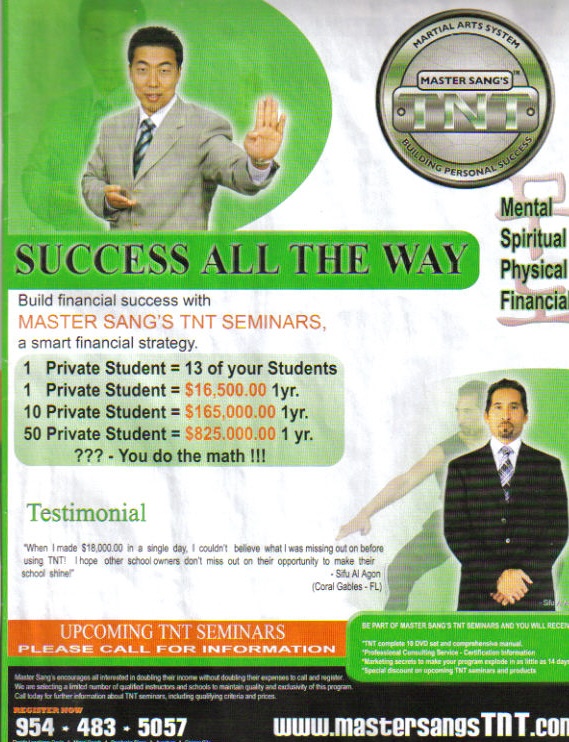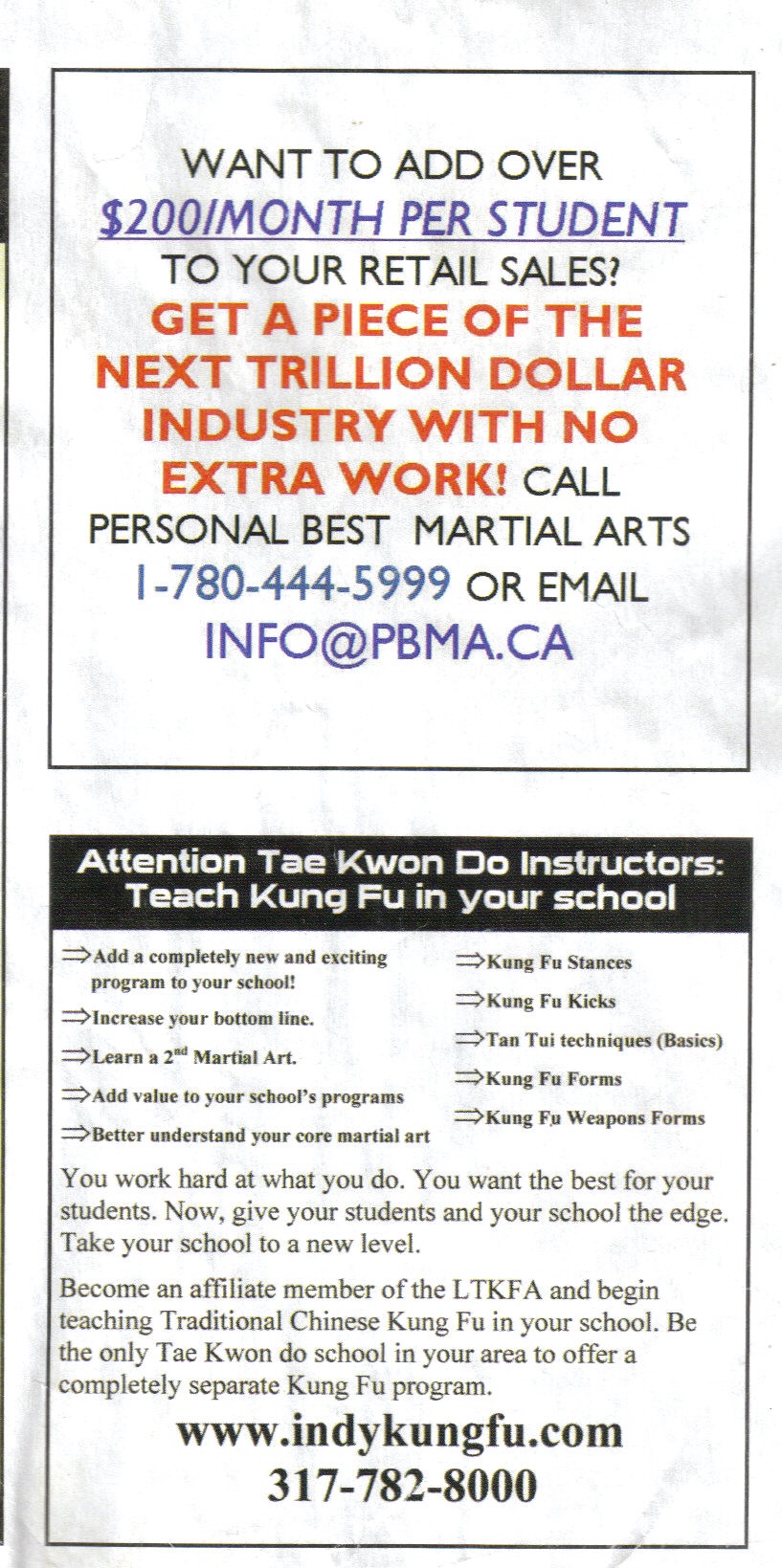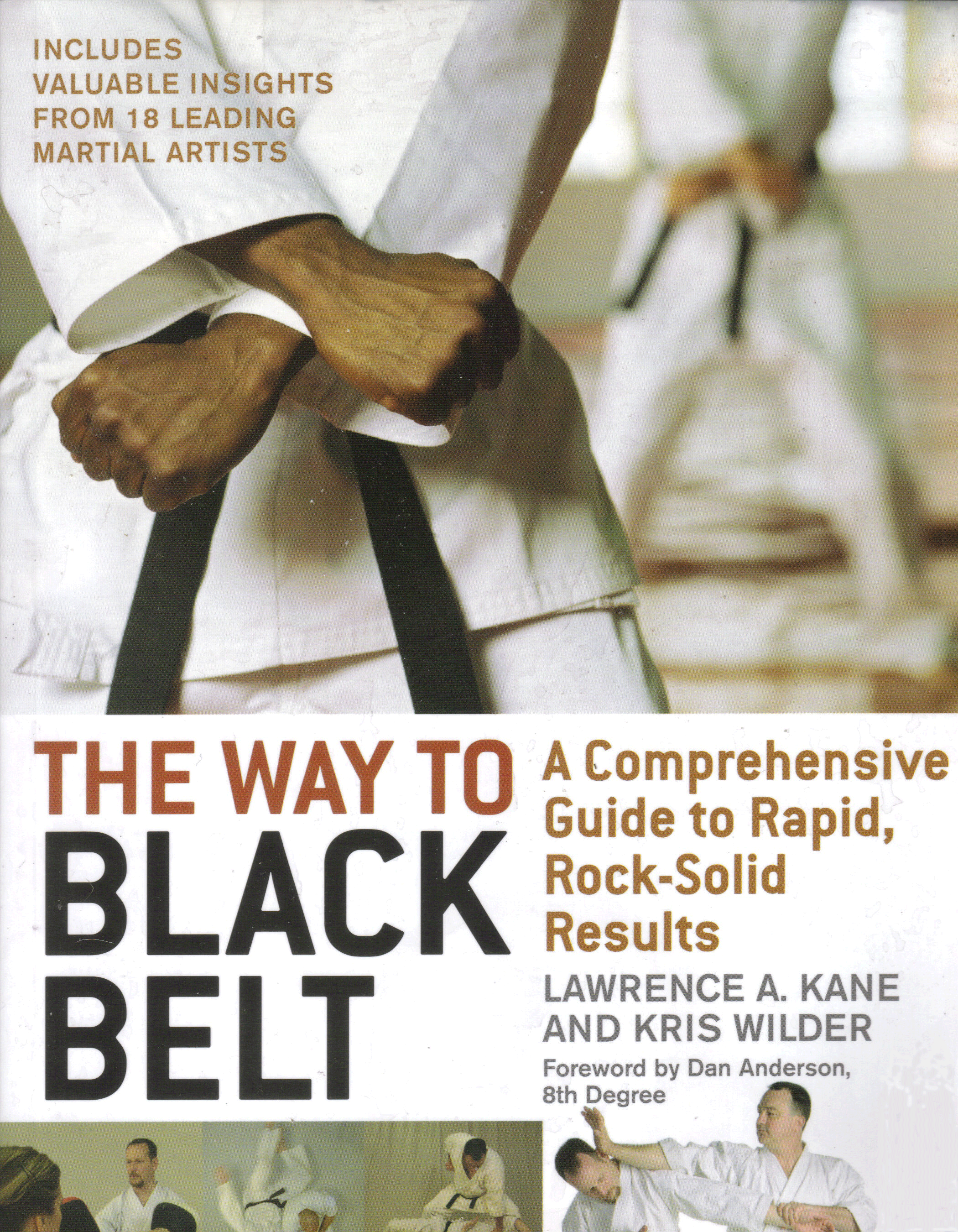|
In This Hub:
Best MA for SD? Bullies Commercialized MA Cults in the MA Evaluating a MA Fighting Facts Fighting vs. Self Defense Four Focuses of MA Training Grappling Know Your Tools Krav Maga Lethal Force and MA Training MA and SD MA Biz MA Lies MA Marketing MA Pirates MA Short Cuts, et all MA Subculture McDojo Mental Preparation Mixed Martial Arts Real Fighting Sanity in MA/SD Self-Defense Sports Martial Arts Strike Enhancers Technique, Don't Dismiss It Threat Displays Traditional MA/Self-Defense Tough Enough? Walking the Talk What Do You Want From MA? What If Monkeys Why We Do It MA Training Hub Self Defense Hub Streetfighting Hub NNSD Home Page
Marc MacYoung? |
The only real security that a man will have in this world is a reserve of knowledge, experience, and ability. Henry Ford
On this page:
It occurred to us that many of the statements we make in the Martial Arts Culture hub about the MA/SD/WSD/RBSD/DT being a hard-core business might not jell with what a lot of people experience in their school. At first glance, those hardworking, sincere individuals who teach most of the classes in your school bear little resemblance to the questionable business -- and other -- practices that we're talking about. That's true... because they aren't the ones raking in the cash. As we stated elsewhere, an overwhelming majority of commercialized schools use non-paid instructors. In fact, many schools have a teaching requirement for students working their way up through the belt/dan system. That means in order to advance in rank, you have to become a volunteer instructor. So the instructor of your class is likely not the school owner, but rather someone who is deeply involved in the martial arts. Because the person who teaches your particular class isn't there for money, the school might not look like a money making operation. Thing is, these "teachers" are themselves still fee paying students. Even if they have a black belt, they're still paying for their dan advancement (1) Why are these student-instructors doing this? Well usually because they believe in what they are teaching and doing. The same goes for many individuals on internet forums who are extolling the virtues of 'their' particular style. That person is getting something other than money out of studying his/her style. And odds are that person spends significant amounts of cash for whatever it is he or she is getting. Often such people become "fan clubs" of the school, style or system's head. The endorsing the person is doing on-line is not paid for the by the school owner/style head, but it definitely profits him. Primarily because it is a form of free advertising. And system/organization forums -- often run by volunteers -- are a double jackpot. So the instructor standing in front of your class or the internet cheerleader don't have the same financial motivations as the school owner. Those people often deeply believe in what they are doing and very committed to the martial art style. And it is that very "sincerity" that puts a fogbank between you and the business practices of the school... As we also repeatedly stated: We don't have a problem with any business that admits it is a business and conducts itself as such -- especially in regard to customer satisfaction and providing the services they claim to offer. For example, NAPMA (National Association of Professional Martial Artists) is one of the largest martial arts organization in the world. And yet, most students have never heard of it. NAPMA is very open and honest that its goal is to help MA school owners run effective and profitable businesses. NAPMA's membership cuts across styles, systems and training focuses. NAPMA offers many valuable services to both the small and big business owner -- including their magazine Martial Arts Professional. Where problems begin to crop up, however is when a business begins to shroud itself in Oriental/combative "mystique." Such schools often put money making in front of quality instruction while making a big production of the "tradition" of the martial arts (or their "street effectiveness"). This is a cash cow dressed up as an Oriental Dragon(2). And this is where a lot of the misconduct discussed in the MA culture hub can begin to creep in. Business pressures have very strong influence on what is being taught in a school. While that is understandable, many organizations have crossed the line. In many cases, you'd be appalled at the amount of money being made. Don't believe us? Wait until you read some of the "professional" ads that students never see. What we are going to do with this page is provide you links and examples of the kind of business practices that you as a student may not see, but are very much a part of the business of the MA/SD/WSD/RBSD/DT world. Then you can compare this "reality" to what you are being told in your school. The advertising your
teacher doesn't want you to see Let's start with four page ads that promise to make your instructor six figures a year. There are countless ads that promise to "increase your cash flow" and profits. And those are just the general thrust of many ads. The following quotes come from actual ads run in "professional" martial arts magazines from June to October 2006. (These aren't in just black and white, these are full-color ad slicks -- which don't come cheap, especially full page ads). The ad that offers "Martial Arts Career Training." Or the ad that offer school owners ways to "discover the hidden fortune in your martial arts schools." An ad that offer a "tried and true formula for school licensing success." (franchising). The ad that proclaims "Breakthrough your school's limitations and make the leap to greater profitability." Oh, and you know all those uniforms and equipment you have to buy? Think about this ad, "Find the hidden product revenues in your school." What about the ad that offers "Here's how to retain your students longer"? How about the ad that reads "the license to succeed! $2,500,000 annual revenue between 4 schools"? Oh and let's not forget the debt collection agency ads that abound for when someone tries to get out of a contract with the school. Of course there are some ads that just have to be seen to be believed...(you can click on any ad to get the full text) Ranking/Certification/Degrees The reason we say "it doesn't help" to look at these documents is that there are entirely too many internet organizations/schools that award certification if you buy their instructor's package. That's right, you can learn these deadly arts -- and be awarded certification -- by simply purchasing a pack of DVDs and books. Then you're ready to teach that art. Buying rank, title and the "qualification" to teach is a big cash cow in the martial arts business world. And with some of these "learn at home" programs running between $500 and $2,000 it is NOT the pimply faced sixteen year old who wants to impress his classmates who are buying these programs. Those are the ones who bother to at least get a smattering of the arts they claim to teach. We'll discuss these added arts in the next section, but right now let's just look at the certification. The prices of "certificates" alone are much, much lower. Here are a set of links to organizations that offer "certification" over the internet.
http://www.kungfufitness.com/details-kungfu-fitness-workout-exercise-program.html These are just a few of the 2,030,000 hits we got from Google when we typed in "martial arts certification program." Go ahead and try it yourself. A purchased certificate from these organizations is often the "qualification" that allows an unscrupulous instructor to put that art on his school's window. Amazingly enough, you can also "buy" a Ph.D from
unaccredited, (often defunct) "universities" on line. For enough money you too
can be a "Doctor" or "Professor" of the martial arts.
http://www.ndcma.com/NationalDragonCouncilUniversityofAsianStudies.html Those are the programs that can be used for outright deceit. From here on it becomes serious shades of grey. For examples, many of these "organizations" that are offering certification are splinter groups that have split away from the established and recognized governing body of a style. These groups with impressive titles rise up and disappear very quickly, often being nothing more than an internet presence. Great logo, great name...but who are they really? It helps to understand that many of these internet organizations offering certification do so because a business practice in many so-called "legitimate" schools/organizations. That is if you leave them, they "strip" you of your rank and title. Your black belt only exists because they say it does. If you leave, you lose your ranking. If an school owner leaves an organization for business or political reasons this loss of rank poses a serious business problem. But...there is an answer. With the signing of just a few checks and the price of a stamp, the old certificates come down off the wall and the new ones go up. The instructor's credibility stays intact with the new set of diplomas and certifications. He's still teaching the same style, but his qualification to teach it comes from a different "organization." Another thing to watch for is seminar certificates. The MA seminar circuit is very lucrative for certain instructors. Often these programs involve a name martial artist who has "representatives" in an area hosting seminars. With enough people hosting these seminars a popular instructor can be on the road for most of each year. A common behavior in these weekend events is to hand out "certificates." You attend and at the end of the seminar, you are "awarded" an impressive and signed proof of attendance. (If you're lucky, you can even get a photo with you and the instructor to hang up next to your certificate). Any number of people use these glamour shots and certificate of training to boost their credibility. Putting it bluntly, just because, you attended a seminar doesn't mean you are qualified to teach a particular MA system. And yet, that is where -- in these kinds of pirate schools -- a lot of what you are being taught comes from. Having said all of this, there are indeed legitimate martial arts organizations. Organizations that have very high standards. Before they award you a certificate, you're going to earn it. Quite frankly, a single ranking document from one of these organizations is worth a wall of the kinds we have been talking about. Return to top of page Added styles With the ease of getting bogus certification that we've discussed you should be starting to wonder about all those different martial arts that you see being advertised on a stripmall dojo's window or yellow page ad. Just how long did an instructor spend getting his "certification" to teach these arts? Using "old school" math, it takes about five years of continuous training to get a black belt in a style (3). Figure for every dan advancement and additional two or three years (although a popular myth is "a year for every dan" i.e. it takes four additional years to become a fourth dan, in addition to the 2 for second, etc). That means in even in commercialized systems, it took 10 to fifteen years of dedicated study in that particular art to reach fifth degree. Now in "ye olde days" when you started a new style, you set your rank aside and started as a white belt in the new style. Your rank didn't transfer. So how'd a 45 year old school owner get those high rankings in 7 different styles? Our calculator says he must be at least 70 years old if he studied at accelerated "old schools" martial art systems that only took 10 years. If you go with 15 years in each art, he'd be 105 (4). That's where the buy-a-certification we spoke about in the last section come in. But that still leaves the question, "Where did the individual learn what he is teaching?" He's teaching something that looks like the martial art he says it is. He has a class syllabus. And he has some basic skills in the subject. Before we answer those questions, let's point something out: The simple fact is that public perception is a major driving force in the marketing of the martial arts. People expect martial arts to involve certain things. When a potential customer walks through the door, there is an expectation that there will be "martial arts weapons" flashing through the air. This is why you see Okinawa based weapon systems (Kobudo) in Japanese and Korean styles. Also courtesy of Remey Presas and his "Modern Arnis" you will probably see Filipino martial arts based stick drills in the same schools. When the grappling fad came about because of Gracies and their Ultimate Fighting Championship all of a sudden, not only did many commercialized schools start offering it, but the mail-order certification and instructors' courses did too. Stop and think about this for a second. If the instructor can't offer whatever fad has dominated the minds of the people walking into his school door, he's going to lose that customer. So that instructor needs to be able to say "Yes, we teach that here." And and odds are the school does have that element added into the curriculum. The fact that the version of what they are teaching at that school is utter crap never occurs to the potential customer or the student who has already signed up. The simple truth is that the people -- looking and seeing whatever it is they expect -- have no idea if what they are seeing is of any quality!(5) Now, that's the general idea. More specifically the public perception is that if you know one martial art the ground work is there so you can easily add another -- and in minimal time. The logic being something like driving a car: Once you know how to drive, then you can adjust to fit any vehicle. nd that is where people selling "added styles" come in. If this were true, then individuals claiming to teach a multitude of styles would be reasonable. The fact is it is not true. But, again public perception is that it is. And that is what drives the market. This brings us back not only to "added styles," but the organizations that will sell your instructor a program in any style he wants to add... And he doesn't even have to go to a different school. They'll not only give you certification, but they'll also give you a pre-packaged curriculum, program guide and teaching tips. Self-defense? You can find that too. Some of the ads we found say it pretty directly, "... is now offering a course you can incorporate into your curriculum. Professional - Well Organized - Easy-to-Follow" Or the Tai Chi program that offers to "Expand your Market, Expand you Mind" How about the weapons system that states "Can be used as a core class or separate add on class program"? And then there is also the lower of the two ads that we showed you previously offering TKD instructors the chance to teach "Kung Fu." So let's see if we're getting this right. An American, practicing a Korean art... that was based on the Japanese version of Okinawan empty hand system that supposedly came from China ... is now going to teach you Chinese Kung Fu too? Having a little bit of experience with different Chinese wushu styles, karate and TKD we can tell you that the body mechanics and movements of these different styles aren't just different, but radically different. If you want an idea how complex it can become, try listening in on some classical Tai Chi arguments about movement and power generation. Just because you know one system of movement doesn't mean you can easily pick up others. And about this generic kung fu style. There are something like 2,000 different wushu styles from China and they are often wildly different from each other in body movement. So what are the odds -- in a school who buys that program -- that what you will be taught as "kung fu" is Tae Kwon Do body movement with Chinese-looking handwork added? You may think you know kung fu. Hey, you even paid to learn it. But the simple truth is that what you would be doing isn't even close to "kung fu." This is regardless of what the certification on the wall says. The long and short of it is that these add-on styles both serve as marketing tools and fluffers for the primary system. By this we mean first, the instructor can say "Yes, we teach that too" and attract more students. Second, these extra programs serve as additional "skills" that the students must learn in order to "complete" the system. Both one and two put more money in the school owner's pockets. But the simple fact is, most examples of this
kind of "cross-training" is like getting Mexican food at Burger King.
It is the fast food version of a type of food, not the authentic
cuisine. Bottom-line In light of the massive amount of money that can be generated through commercialized schools you-- as the customer -- have the right to demand quality service AND information. The contract that most schools have you sign these days works both ways. You wouldn't pay the same price as a meal at the best restaurant in town for a McDonald's Happy Meal, so why should you tolerate paying top dollar for bad martial arts instruction? You have every right to demand quality service and instruction for the prices that you are paying. And as this page demonstrates, there is a lot of money to be made from bad martial arts instruction. Make sure you are getting what you pay for.
1) This isn't just free labor. That would be an impressive enough racket as is. No, you have to pay to teach for them. Stop and do the math on this idea. Not only are all the students paying the school, but so is the person teaching the class! In what is essentially a bare room, with no "product overhead," everyone is paying the school owner to be there. And the owner only has to spend -- maybe -- one class a night teaching. What you want to see is a whole lot of the owner of the school on the floor teaching -- and not just the high belts either Return to Text 2) Our friend Professor Jeff Gaynor has some pretty -- well it depends on your point of view if it is "interesting" or "unsettling" -- things to say about martial artists who are enamored over the dream of Oriental warrior culture and foggy on history to boot. http://jqhome.net/ma/common/samurai.html. Although primarily focused on the Samurai, you can find some thought provoking ideas about the "history" of whatever style you study -- especially because it is these very misconceptions that so many MA schools hide their business behind. Return to Text 3) We say "old school math" because just down the road from us there is a school that is part of an incredibly popular franchise that guarantees you a black belt in a year -- for about $2,400 and additional costs. (There's a reason they only engage in inter-school tournaments). Now if this is the kind of training that someone is using, then it makes sense for someone to be able to have a massive list of high rankings. Return to Text 4) That's IF you are talking about commercialized Western schools. In in many cases with the original Oriental training programs, fifteen years would have you about the rank of a senior student. We know several of these kinds of instructors and, to a man, they have had their senior students for 20 to 30 years -- in ONE style. The students are amazing martial artists. Their body movement, timing, fluidity and " kinesthetic linkage" just blows those McDojo, uber-masters of multiple arts out of the water. It's like watching a ballerina dancing next to a bear in a tutu. And this is the reason why so many stripmall "masters" can pull it off, to an untrained and inexperienced person, the level of skill they have IS impressive. It isn't until you see them perform next to someone who is well versed in their art that you can see the difference in movement and skill. Return to Text 5) Obviously this criticism applies in spades to self-defense and personal safety. This Webpage is filled with information about personal safety and how crime occurs that you will not learn in a martial art school. However, "personal safety" is often far more of a "soft science" that doesn't have safe and easily demonstrable examples of flawed teaching or the student thinking that he/she is getting the real enchilada. Therefore, the example we like to use -- because it can be demonstrated safely -- is martial arts weapons. Effective weapon usage is more than simply wagging it around in a kata. It is definitely more than whirling a modified and lightened version of the weapon in a tournament. The simple fact is: There is a big difference between holding a weapon and holding it correctly. When correctly held, your entire body creates a structure that allows you to withstand and deliver force through your weapon. These are small "tweaks" that prevent the weapon from being knocked or twisting out of your hand when using it. The test we were talking about is simple: In the safety of the school and wearing protective equipment, have someone swing a weapon at you full strength and you block. That weapon you are blocking with should not be able to be knocked out of your hand if the training you received isn't flawed. In fact, when correctly held, you should be able to both strike and block with the weapon and it NOT hurt. If it hurts or you drop your weapon, then you were taught flawed information about weapon use. Return to text |

|
||||||
|
||||||||













